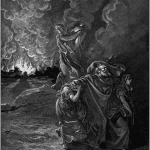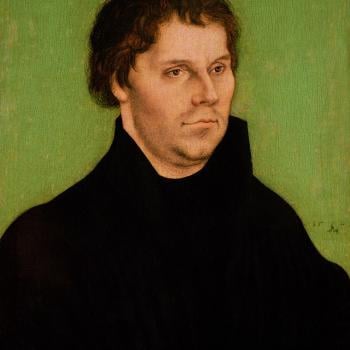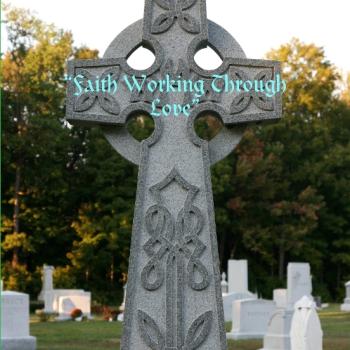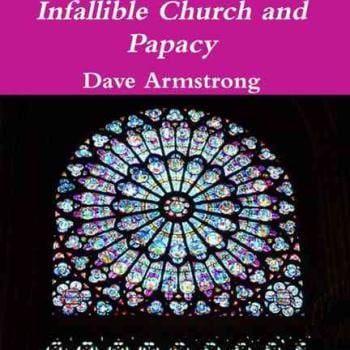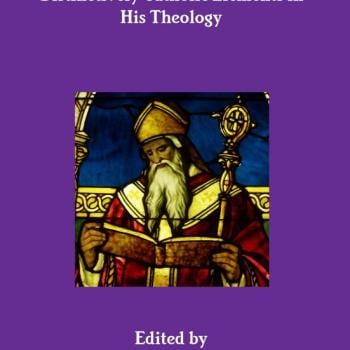1) Erasmus (The leading scholar in Europe: 1521)
I greatly wonder, my dear Jonas, what god has stirred up the heart of Luther, in so far as he assails with such license of pen the Roman pontiff, all the universities, philosophy, and the mendicant orders . . .
Perhaps there were some who out of honest zeal favored calling the orders and princes of the Church to better things. But I do not know if they are those who under this pretext covet the wealth of the churchmen. I judge nothing to be more wicked and destructive of public tranquility than this . . . This certainly is a fine turn of affairs, if property is wickedly taken away from priests so that soldiers may make use of it in worse fashion; and the latter squander their own wealth, and sometimes that of others, so that no one benefits.
(in Christian Humanism and the Reformation, [selections from Erasmus], edited and translated by John C. Olin, New York: Harper & Row, 1965, 152, 157-159, 161-163; Letter to Jodocus Jonas, from Louvain, May 10, 1521)
2) Hartmann Grisar (Catholic historian) / Martin Luther (1522)
Count Johann Heinrich of Schwarzburg became the founder of Lutheranism in his territories in virtue of a decree authorized by Luther . . . Luther replied on December 12, 1522 that Count Gunther had naturally expected the monks to preach the Gospel, but “if witnesses could testify that they did not preach the true Gospel (of Luther), but papistical heresies, the count would have the right, nay, the duty, to oust them from their parishes.”
[Luther] For it is not unlawful, indeed, it is absolutely right to drive the wolf from the sheepfold . . . A preacher is not given property and tithes in order that he should do injury, but that he should labor profitably. If he does not work to the advantage of the people, the endowments are his no longer.
[ . . . ]
This principle was promptly applied at Schwartzburg. The Count seized the properties and revoked the privileges which his father had given to the Church . . . Luther’s reply concerning temporal possessions, taken in connection with certain other statements made by him, reveals an idea truly revolutionary in its consequences. It indicated that, if the clergy refused to preach the new religion, in Germany and in the Church in general, ecclesiastical possessions were no longer secure . . . It is hardly probable that Luther realized in advance all the consequences of his decision in the Schwarzburg affair, though practically it had been acted upon ever since the beginning of the new movement.
(Martin Luther: His Life and Work, translated from the 2nd German edition by Frank J. Eble, Westminster, Maryland: The Newman Press, 1950; originally 1930, 228-229)
Partial translation in Grisar, Luther, translated by E.M. Lamond, edited by Luigi Cappadelta, 6 volumes, London: Kegan Paul, Trench, Trubner & Co., 1915; Vol. VI, 244: Luther: “If the preacher does not make men pious, the goods are no longer his.”
3) Martin Luther (1523)
. . . there is need of great care, lest the possessions of such vacated foundations become common plunder and everyone make off with what he can get . . . the blame is laid at my door whenever monasteries and foundations are vacated . . . This makes me unwilling to take the additional blame if some greedy bellies should grab these spiritual possessions and claim, in excuse of their conduct, that I was the cause of it . . .
In the first place: it would indeed be well if no rural monasteries, such as those of the Benedictines, Cistercians, Celestines, and the like, had ever appeared upon earth. But now that they are here, the best thing is to suffer them to pass away or to assist them, wherever one properly can, to disappear altogether. This may be done in the following ways. first, by suffering the inmates to leave, if they choose, of their own free will . . .
[then follows an exhortation to charitably provide for those who won’t or can’t leave]
I advise the temporal authorities, however, to take over the possessions of such monasteries . . . it is not a case of greed opposing the spiritual possessions, but of Christian faith opposing the monasteries . . . I am writing this for those only who understand the Gospel and who have the right to take such action in their own lands, cities and jurisdiction . . .
. . . the third way is best, namely, to devote all remaining possessions to the common fund of a common chest, out of which gifts and loans might be made, in Christian love, to all the needy in the land, whether nobles or commons . . .
I am setting down this advice in accordance with Christian love for Christians alone. We must expect greed to creep in here and there . . . it is better that greed take too much in an orderly way than that the whole thing become common plunder, as it happened in Bohemia. Let everyone examine himself to see what he should take for his own needs and what he should leave for the common chest.
In the third place: the same procedure should be followed with respect to abbacies, foundations, and chapters in control of lands, cities and other possessions. For such bishops and foundations are neither bishops nor foundations; they are really at bottom temporal lords sailing under a spiritual name . . .
In the fourth place: part of the possessions of the monasteries and foundations . . . are based upon usury, which now calls itself everywhere “interest,” and which has in but a few years swallowed up the whole world . . . God says, “I hate robbery for burnt offering.” [Is 61:8] . . .
But whosoever will not follow this advice nor curb his greed, of him I wash my hands.
(Preface to an Ordinance of a Common Chest, in Works of Martin Luther [Philadephia edition [PE], IV, 92-98, translated by A.T.W. Steinhaeuser; WA, XII, 11-30; EA, XXII, 106-130; citations from 93-98)
Who does not see that all bishops, foundations, monastic houses, universities, with all that are therein, rage against this clear word of Christ . . .? Hence they are certainly to be regarded as murderers, thieves, wolves and apostate Christians . . .
. . . the hearers not only have the power and the right to judge all preaching, but are obliged to judge it under penalty of forfeiting the favor of Divine Majesty. Thus we see in how unchristian a manner the despots dealt with us when they deprived us of this right and appropriated it to themselves. For this thing alone they have richly deserved to be cast out of the Christian Church and driven forth as wolves, thieves and murderers . . .
(The Right and Power of a Christian Congregation or Community to Judge all Teaching and to Call, Appoint, and Dismiss Teachers, Established and Proved From Scripture, PE, IV, 75-85, translated by A.T.W. Steinhaeuser; WA, XI, 406 ff.; EA, XXII, 141 ff.; citations from 75-79)
4) Warren Carroll (Catholic historian) / Lutherans (1530)
Early in July the bishops presented their complaints to the Diet [of Augsburg: 1530] of the plundering and destruction of churches, seizure of monasteries and hospitals, prohibition of Masses, and attacks on religious processions by the Protestants. When Charles called upon the Protestants to restore the property they had seized, they said that to do so would be against their consciences. Charles responded crushingly: ‘The Word of God, the Gospel, and every law civil and canonical, forbid a man to appropriate to himself the property of another.’ He said that as Emperor he had the duty of guarding the rights of all, especially those Catholics unwilling to accept Protestantism or go into exile, who should at least be allowed to remain in their homes and practice their ancestral faith, specifically the Mass; the Protestants replied that they would not tolerate the Mass . . .
(The Cleaving of Christendom; from the series, A History of Christendom, Volume 4, Front Royal, Virginia: Christendom Press, 2000, 103-107)
5) Martin Luther (1541)
Luther was still rationalizing this outrageous and unjust criminal theft in 1541:
If they are not the church but the devil’s whore that has not remained faithful to Christ, then it is irrefutably and thoroughly established that they should not possess church property.
(Wider Hans Wurst, or Against Jack Sausage, in Luther’s Works [LW], vol. 41, 179-256, translated by Eric W. Gritsch; citation from p. 220)
6) A History of the Protestant Reformation in England and Ireland (1826), by the non-Catholic social reformer William Cobbett (1763-1835). The online introduction to the book notes:
Cobbett’s ideas found little favour with “respectable” historians then or for long afterwards . . . It is interesting, however, to note that one of Cobbett’s theses — that the Reformation in England had little popular support and was the product of a handful of fanatics backed by the awesome power of the Tudor Monarchy and supported by the greed of those who looted the monasteries and Churches — is now increasingly being accepted by historians. See for example the TV series and book A History of Britain by Simon Schama, or the more specialised and detailed account The Stripping of The Altars by Eamon Duffy.
Here are some excerpts from Cobbett:
54. When I come to speak of the measures by which the monasteries were robbed, devastated and destroyed in England and Ireland, I shall show how unjust, base and ungrateful, this railing against them is; and how foolish it is besides. I shall show the various ways in which they were greatly useful to the community; and I shall especially show how they operated in behalf of the labouring and poorer classes of the people. But, in this place, I shall merely describe, in the shortest manner possible, the origin and nature of those institutions, and the extent to which they existed in England.
60. England, more, perhaps, than any other country in Europe, abounded in such institutions, and these more richly endowed than any where else. In England, there was, on an average, more than twenty (we shall see the exact number by-and-by) of those establishments to a county! Here was a prize for an unjust and cruel tyrant to lay his lawless hands upon, and for “Reformation” gentry to share amongst them! Here was enough, indeed, to make robbers on a grand scale cry out against “monkish ignorance and superstition”! No wonder that the bowels of CRANMER, KNOX, and all their mongrel litter, yearned so piteously as they did, when they cast their pious eyes on all the farms and manors, and on all the silver and gold ornaments belonging to these communities! We shall see, by-and-by, with what alacrity they ousted, plundered, and pulled down: we shall see them robbing, under the basest pretences, even the altars of the country parish churches, down to the very smallest of those churches, and down to the value of five shillings. But, we must first take a view of the motives which led the tyrant, Henry VIII., to set their devastating and plundering faculties in motion.
64. By making himself the supreme head of the Church, he made himself, he having the sword and the gibbet at his command, master of all the property of that Church, including that of the monasteries! His counsellors and courtiers knew this; and, as it was soon discovered that a sweeping confiscation would take place, the parliament was by no means backward in aiding his designs, every one hoping to share in the plunder. The first step was to pass acts taking from the POPE all authority and power over the Church in England, and giving to the King all authority whatever as to ecclesiastical matters. . . .
119. In paragraphs from 55 to 60 inclusive, we have seen how monasteries arose, and what sort of institutions they were. There were, in England, at the time we are speaking of, 645 of these institutions; besides 90 Colleges, 110 Hospitals, and 2374 Chantries and Free-Chapels. The whole were seized on, first and last, taken into the hands of the King, and by him granted to those who aided and abetted him in the work of plunder.
120. I pray you, my friends, sensible and just English men, to observe here, that this was a great mass of landed property; that this property was not by any means used for the sole benefit of monks, friars, and nuns; that, for the far greater part, its rents flowed immediately back amongst the people at large; and, that, if it had never been an object of plunder, England never would, and never could, have heard the hideous sound of the words pauper and poor-rate. You have seen, in paragraph 52, in what manner the tithes arose
and how they were disposed of; and you are, by-and-by, to see how the rents of the monasteries were distributed.
156. We have already seen something of these pretences, motives and acts of tyranny and barbarity; we have seen that the beastly lust of the chief tyrant was the groundwork of what is called the “Reformation”; we have seen that he could not have proceeded in his course without the concurrence of the Parliament; we have seen that, to obtain that concurrence, he held out to those who composed it a participation in the spoils of the Monasteries; and, when we look at the magnitude of their possessions, when we consider the beauty and fertility of the spots on which they, in general, were situated, when we think of the envy which the love borne them by the people must have excited in the hearts of a great many of the noblemen and
gentlemen; when we thus reflect, we are not surprised, that these were eager for a “Reformation” that promised to transfer the envied possessions to them.
160. The monks and nuns, who had never dreamed of the possibility of such proceedings, who had never had an idea that Magna Charta and all the laws of the land could be set aside in a moment, and whose recluse and peaceful lives rendered them wholly unfit to cope with at once crafty and desperate villany, fell before these ruffians as chickens fall before the kite. The reports, made by these villains, met with no contradiction; the accused parties had no means of making a defence; there was no court for them to appear in; they dared not, even if they had the means, to offer a defence or make a complaint; for they had seen the horrible consequences, the burnings, the rippings up, of all those of their brethren who had ventured to whisper their dissent from any dogma or decree of the tyrant. The project was to despoil people of their property; and yet the parties, from whom the property was to be taken, were to have no court in which to plead their cause, no means of obtaining a hearing, could make even no complaint but at the peril of their lives. They, and those who depended on them, were to be, at once, stripped of this great mass of property, without any other ground than that of reports, made by men, sent, as the malignant HUME himself confesses, for the express purpose of finding a pretence for the dissolution of the Monasteries and for the King’s taking to himself property that had never belonged to him or his predecessors.
7) Will Durant (secular historian)
The cities found Protestantism profitable . . . for a slight alteration in their theological garb they escaped from episcopal taxes and courts, and could appropriate pleasant parcels of ecclesiastical property . . . The princes . . . could be spiritual as well as temporal lords, and all the wealth of the Church could be theirs . . . The Lutheran princes suppressed all monasteries in their territory except a few whose inmates had embraced the Protestant faith.
(The Reformation, [volume 6 of 10-volume The Story of Civilization, 1967], New York: Simon & Schuster, 1957, 438-439)
8) Hilaire Belloc (Catholic historian)
There came – round about 1536-40 — a change . . . The temptation to loot Church property and the habit of doing so had appeared and was growing; and this rapidly created a vested interest in promoting the change of religion. Those who attacked Catholic doctrine, as, for instance, in the matters of celibacy in the monastic orders . . . opened the door for the seizure of the enormous clerical endowments . . . by the Princes . . . The property of convents and monasteries passed wholesale to the looters over great areas of Christendom: Scandinavia, the British Isles, the Northern Netherlands, much of the Germanies and many of the Swiss Cantons. The endowments of hospitals, colleges, schools, guilds, were largely though not wholly seized . . . Such an economic change in so short a time our civilization had never seen . . . The new adventurers and the older gentry who had so suddenly enriched themselves, saw, in the return of Catholicism, peril to their immense new fortunes.
(Characters of the Reformation, Garden City, New York: Doubleday Image, 1958, 9-10)
The great Scottish nobles . . . supported the religious revolution because it gave them the power to loot the Church and the monarchy wholesale.
(Ibid., 112)
9) A. G. Dickens (Protestant historian)
In Sweden Gustavus Vasa deprived the Church of all its landed properties . . . The proportion of land held by the crown increased during his reign from 5.5% to 28%: that of the Church from 21% to nil.
(Reformation and Society in 16th-Century Europe, London: Harcourt, Brace & World, 1966, 191)
10) Henri Daniel-Rops (Catholic historian)
Right from the beginning, Luther’s spiritual revolt had let loose material greed. The German rulers, the Scandinavian monarchs and Henry VIII of England had all taken advantage of the break from papal tutelage to appropriate both the wealth and the control of their respective Churches.
(The Protestant Reformation, Vol. 2, translated by Audrey Butler, Garden City, New York: Doubleday Image, 1961, 309-310)
11) Lutheran Philip Melanchthon on the German Princes
They do not care in the least about religion; they are only anxious to get dominion into their hands, to be free from the control of bishops . . . Under cover of the Gospel, the princes were only intent on the plunder of the Churches.
(in Durant, ibid., 438, 440)
12) Wikipedia: “Dissolution of the Monasteries”:
The Dissolution of the Monasteries, sometimes referred to as the Suppression of the Monasteries, was the formal process between 1536 and 1541 by which Henry VIII disbanded monastic communities in England, Wales and Ireland and confiscated their property. He was given the authority to do this by the Act of Supremacy, passed by Parliament in 1534, which made him Supreme Head of the Church in England, and by the First Suppression Act (1536) and the Second Suppression Act (1539). . . .
European Precedents
While these transactions were going on in England, elsewhere in Europe events were taking place which presaged a storm. In 1521, Martin Luther had published ‘De votis monasticis’ (Latin: ‘On the monastic vows’), a treatise which declared that the monastic life had no scriptural basis, was pointless and also actively immoral in that it was not compatible with the true spirit of Christianity. Luther also declared that monastic vows were meaningless and that no one should feel bound by them. These views had an immediate effect: a special meeting of German members of the Augustinian Friars, (of which Luther was part) held the same year accepted them and voted that henceforth every member of the regular clergy should be free to renounce their vows, resign their offices and to get married. At Luther’s home monastery in Wittenberg all the monks but one did so.
News of these events did not take long to spread among Protestant-minded (and acquisitive) rulers across Europe, and some, particularly in Scandinavia, moved very quickly. In Sweden in 1527 King Gustavus Vasa secured an edict of the Diet allowing him to confiscate any monastic lands he deemed necessary to increase royal revenues; and to force the return of properties to the descendents of those who had donated them. Gustav thus gained large estates for himself while acquiring a trane of diehard supporters. The Swedish monasteries and convents were simultaneously deprived of their subsistence, with the result that some collapsed immediately, while others lingered on for a few decades before persecution and forfeitures finally caused them all to disappear by 1580. In Denmark, King Frederick I of Denmark made his grab in 1528, confiscating 15 of the houses of the wealthiest monasteries and convents. Further laws under his successor over the course of the 1530s banned the friars, and forced monks and nuns to transfer title to their houses to the crown, which parsed them out to supportive nobles, who were soon found enjoying the fruits of the former monastic lands. Danish monastic life was to vanish in a way identical to that of Sweden.
In Switzerland, too, monasteries came under threat. In 1523 the government of the city-state of Zurich pressured nuns to leave their convents and marry, and followed up the next year by dissolving all monasteries in its territory, under the pretext of using their revenues to fund education and help the poor. The former religious who cooperated with the scheme were offered help with learning a trade for their new secular lives and in some instances were granted pensions. The city of Basel followed suit in 1529 and Geneva adopted the same policy in 1530. An attempt was also made in 1530 to dissolve the famous Abbey of St. Gall, which was a state of the Holy Roman Empire in its own right, but this ultimately failed and St Gall survived.
It is impossible that these moves went unnoticed by the English government and particularly by Thomas Cromwell, shortly to become Henry VIII’s chief minister, who promised to make his king wealthier than any previous English monarch.
Process
On failing famously to receive his desired annulment from the Pope, Henry had himself declared Supreme Head of the Church in England in February 1531. In April 1533 an Act in Restraint of Appeals eliminated the right of clergy to appeal to “foreign tribunals” (Rome) over the King’s head in any spiritual or financial matter.
In 1534 Henry had Parliament authorise Thomas Cromwell, to “visit” all the monasteries (which included all abbeys, priories and convents), ostensibly to make sure their members were instructed in the new rules for their supervision by the King instead of the Pope, but actually to inventory their assets (see Valor Ecclesiasticus). A few months later, in January 1535 when the consternation at having a lay visitation instead of a bishop’s had settled down, Cromwell’s visitation authority was delegated to a commission of laymen including Layton, Pollard and Moyle, for the purpose of ascertaining what wealth the monasteries held and find pretexts for the plunder that was about to ensue. This phase is termed the “Visitation of the Monasteries.”
In the summer of that year, the visitors started their work, and “preachers” and “railers” were sent out to deliver sermons from the pulpits of the churches on three themes:
- The monks and nuns in the monasteries were called sinful “hypocrites“, “sorcerers” and “idle drones”, who were living lives of luxury and engaging in every kind of sin;
- Those monks and nuns were living off the working people and giving nothing back and, thus, were a serious drain on England’s economy;
- If the King received all the property of the monasteries, he would never again need taxes from the people.
Meanwhile, during the autumn of 1535, the visiting commissioners were sending back to Cromwell written reports of all the lurid doings they claimed to be discovering, sexual as well as financial. A “horrified” Parliament enacted laws in early 1536, relying in large part on the reports of “impropriety” Cromwell had received, provided for the King to seize all the monasteries with annual incomes of less than £200, and this was quickly done: the smaller, less influential houses were emptied, their properties confiscated and those monks and nuns who cooperated were given preferments or pensioned off. Those who resisted were imprisoned or executed. Monastic life had already seen some decline. By 1536, the thirteen Cistercian houses in Wales held only 85 monks amongst them. However, the claims of misbehaviour were greatly exaggerated.
These moves did not raise as much capital as had been expected, even after the king re-chartered some of the confiscated monasteries he confiscated them yet again. In April 1539 a new Parliament passed a law giving the King the rest of the monasteries in England. Some of the abbots resisted, and that autumn the abbots of Colchester, Glastonbury, and Reading were hanged, drawn and quartered for treason. (The Carthusian priors of Beauvale, London, and Axholme, were executed in 1535 for refusal to recognise Henry’s Act of Supremacy.) St. Benet’s Abbey in Norfolk was the only abbey in England which escaped dissolution.
The other abbots signed their abbeys over to the King. Some of the confiscated church buildings were destroyed for the valuable lead, and the slate roofs and stone sold or reused for secular buildings. Some of the smaller Benedictine houses were taken over as parish churches, and were even bought for the purpose by wealthy parishes. The tradition that there was widespread destruction and iconoclasm, that altars and windows were smashed, partly confuses the damage done in the 1530s with the damage wreaked by the Puritans in the next century. Relics were burned and pilgrimages prohibited. Great abbeys and priories like Glastonbury, Walsingham, Bury St Edmunds, Shaftesbury and Canterbury, which had flourished as pilgrimage destinations, were ruined.
Still, Henry needed more money; so many of the abbeys now in his possession were resold to the new Tudor gentry, binding them as a class most firmly to the new Protestant settlement.
Consequences
The abbeys of England, Wales and Ireland had been among the greatest landowners and the largest institutions in the kingdom. Particularly in areas far from London, the abbeys, convents and priories were the principal centres of hospitality, learning, patronage of artists and craftsmen and sources of charity and medical care. The removal of over eight hundred such institutions, virtually overnight, rent vast gaps in the social fabric.
It is unlikely that the monastic system could have been broken simply by royal action had there not been the overwhelming bait of personal enrichment for gentry large and small, and the convictions of the small but determined Protestant faction. Anti-clericalism was a familiar feature of late-medieval Europe, producing its own strain of satiric literature that was aimed at a literate middle class.
Along with the destruction of the monasteries, some many hundreds of years old, the related destruction of the monastic libraries was perhaps the greatest cultural loss caused by the English Reformation. Worcester Priory (now Worcester Cathedral) had 600 books at the time of the dissolution. Only six of them have survived intact to the present day. At the abbey of the Augustinian Friars at York, a library of 646 volumes was destroyed, leaving only three surviving books. Some books were destroyed for their precious bindings, others were sold off by the cartload, including irreplaceable early English works. It is believed that many of the earliest Anglo-Saxon manuscripts were lost at this time. . . .
Monastic hospitals were also lost, with devastating consequences for the locals. Monasteries had also supplied free food and alms for the poor and destitute. The removal of this resource was one of the factors in the creation of the army of “sturdy beggars” that plagued late Tudor England, causing the social instability that led to the Edwardian and Elizabethan Poor Laws. On the eve of the overthrow, the various monasteries owned approximately 2,000,000 acres, over 16 percent of England, with tens of thousands of tenant farmers working those lands. The monastic landlords were appreciated for their more lenient terms, and some of their tenant families had lived on monastery lands for many generations. The aristocrats who displaced them soon demanded higher rents, immediate payment and greater productivity from their tenants. . . .
The dissolution and destruction of the monasteries and shrines was very unpopular in many areas. In the north of England, centering on Yorkshire and Lincolnshire, the suppression of the monasteries led to a popular rising, the Pilgrimage of Grace, that threatened the crown for some weeks. The demand for the restoration of some monasteries resurfaced later, in the West Country Prayer Book Rebellion of 1549. . . .
In 1536 there were major popular risings in Lincolnshire and Yorkshire and, a further rising in Norfolk the following year. Rumours were spread that the King was going to strip the parish churches too, and even tax cattle and sheep. The rebels called for an end to the dissolution of the monasteries, for the removal of Cromwell, and for Henry’s daughter, and eldest child, the Catholic Mary to be named as successor in place of his younger son Edward. Henry defused the movement with solemn promises, all of which went unkept, and then summarily executed the leaders.
[see also a list of the monasteries dissolved]
13) Catholic Encyclopedia: “Suppression of English Monasteries Under Henry VIII”:
It is somewhat difficult to estimate correctly the number of religious houses which passed into the king’s possession in virtue of the Act of Parliament of 1536. Stowe’s estimate is generally deemed sufficiently near the mark, and he says: “the number of the houses then suppressed was 376.” . . .
No sooner had the process of destruction begun simultaneously all over the country than the people began at last to realize that the benefits likely to accrue to them out of the plunder were most illusory. When this was understood, it was first proposed to present a petition to the king from the Lords and Commons, pointing out the evident damage which must be done to the country at large if the measure was carried out fully; and asking that the process of suppression should be at once stopped, and that the lesser houses, which had not yet been dissolved under the authority of the Act of 1536, should be allowed to stand. Nothing, of course, came of this attempt. Henry’s appetite was but whetted by what had come to him, and he only hungered for more of the spoils of the Church and the poor. The action of the Parliament in 1536 in permitting the first measure to become law made it in reality much more difficult for Henry to draw back; and in more senses than one it paved the way for the general dissolution. Here and there in the country active resistance to the work of destruction was organized, and in the case of Lincolnshire, Yorkshire, and the North generally, the popular rising of the “pilgrimage of grace” was caused in the main, or at least in great measure, by the desire of the people at large to save the religious houses from ruthless destruction. The failure of the insurrection of the “Pilgrimage of Grace” was celebrated by the execution of twelve abbots, and, to use Henry’s own words, by a wholesale “tying-up” of monks. By a new and ingenious process, appropriately called “Dissolution by Attainder“, an abbey was considered by the royal advisers to fall into the king’s hands by the supposed or constructive treason of its superior. In this way several of the larger abbeys, with all their revenues and possessions, came into Henry’s hands as a consequence of the “Pilgrimage of Grace”. . . .
The autumn of 1537 saw the beginning of the fall of the friaries in England. For some reason, possibly because of their poverty, they had not been brought under the Act of 1536. For a year after the “Pilgrimage of Grace” few dissolutions of houses, other than those which came to the king by the attainder of their superiors, are recorded. With the feast of St. Michael, 1537, however, besides the convents of friars the work of securing of securing, by some means or other, the surrender of the greater houses went on rapidly. The instructions given to the royal agents are clear. They were, by all methods known to them, to get the religious “willingly to consent and agree” to their own extinction. It was only when they found “any of the said heads and convents, so appointed to be dissolved, so wilful and obstinate that they would in no wise” agree to sign and seal their own death-warrant, that the commissioners were authorized by Henry’s instructions to “take possession of the house” and property by force. And whilst thus engaged, the royal agents were ordered to declare that the king had no design whatsoever upon the monastic property or system as such, or any desire to secure the total suppression of the religious houses. . . . In 1538 and 1539 some 150 monasteries of men appear to have signed away their corporate existence and their property, and by a formal deed handed over all rights to the king.
When the work had progressed sufficiently the new Parliament, which met in April, 1539, after observing that divers abbots and others had yielded up their houses to the king, “without constraint, coercion, or compulsion”, confirmed these surrenders and vested all monastic property thus obtained in the Crown. Finally in the autumn of that year, Henry’s triumph over the monastic orders was completed by the horrible deaths for constructive treason of the three great abbots of Glastonbury, Colchester, and Reading. And so, as one writer has said, “before the winter of 1540 had set in, the last of the abbeys had been added to the ruins with which the land was strewn from one end to the other.”
13) “The Dissolution of the Monasteries,” Matthew E. Bunson, This Rock (December 2006).
- Geoffrey Baskerville, English Monks and the Suppression of the Monasteries (1937)
- Brendan Bradshaw, The Dissolution of the Religious Orders in Ireland under Henry VIII (1974)
- Howard Colvin, The History of the King’s Works
- J.C.K. Cornwall, Wealth and Society in Early Sixteenth-Century England (Cambridge 1988)
- A. G. Dickens, The English Reformation (2nd ed. London 1989)
- Eamon Duffy (1992). The Stripping of the Altars: Traditional Religion in England, 1400–1580. Yale University Press ISBN 0-300-06076-9. An interpretation radically different from that contained in this article. Duffy maintains that Henry VIII’s reformation was in many ways a radical Protestant reformation, that Mary I’s attempt to restore Catholicism was a Counter-Reformation effort and that her form of Catholicism was considerably different from that which Henry VIII had swept away.
- F. A. Gasquet, Henry VIII and the English Monasteries (8th ed. London 1925)
- C. Haigh, The Last Days of the Lancashire Monasteries and the Pilgrimage of Grace (1969)
- ——, Reformation and Resistance in Tudor Lancashire (Cambridge 1975)
- David Knowles, The Religious Orders in England, vol III (1959)
- H. F. M. Prescott (1952). The Man on a Donkey. A finely researched novel, set in the form of a chronicle, of Henry VIII’s dissolution of monasteries and the answering rebellion in the North, the Pilgrimage of Grace
- A. Savine, English Monasteries on the Eve of the Dissolution (Oxford 1909)
- J. Youings, The Dissolution of the Monasteries (1971)


